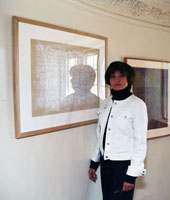At a distance you see an engrossing painting in muted complimentary colors, blues and orange-browns. If you move  close to this canvas you’ll see that things are glued onto it. At (2) there’s a distressed black rectangle with a yellow band at the bottom that has a zig-zag line on it. At (3) the artist painted a continuation of (2). At (1) we find a rich brown patch that is actually a piece of sand paper. At (4), some pieces of cloth and frayed canvas.
close to this canvas you’ll see that things are glued onto it. At (2) there’s a distressed black rectangle with a yellow band at the bottom that has a zig-zag line on it. At (3) the artist painted a continuation of (2). At (1) we find a rich brown patch that is actually a piece of sand paper. At (4), some pieces of cloth and frayed canvas.
The realization that these banal objects on the canvas [(2) is some rubber that was found on the street] are used so harmoniously in the painting is thrilling to any modernist. This juxtaposition of aesthetics and the mundane marks modernism.
Before 1912 painters did not glue anything onto their drawings or paintings. That summer in 1912, however, Georges Braque saw some fake wood grain wall paper in a store window, bought a roll and pasted strips of it into his charcoal drawings. The audacity! You call that art!? Art was expected to emanate from some higher power and remind us of lofty ideals to live up to. Now this! Even Picasso was shocked. But he immediately understood that collage was another way to subvert the ideals of the Renaissance and so, of course, he was all for it. Thus we have the beginning of Synthetic Cubism, which gave us a new way of staying alert when looking at art and life. Thank you, Braque!
Painting with mixed media by Terry Fohrman, oil on canvas on board, ~20” x 16”
Georges Braque 1881-1963
https://artamaze.wordpress.com/?s=picasso
https://artamaze.wordpress.com/?s=braque
All contents copyright (C) 2010 Katherine Hilden. All rights reserved.



[…] « Found Objects […]
[…] https://artamaze.wordpress.com/2016/09/28/found-objects/ […]